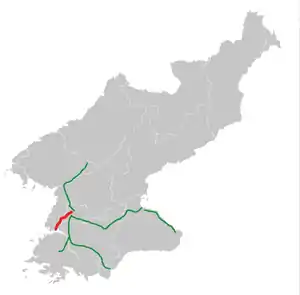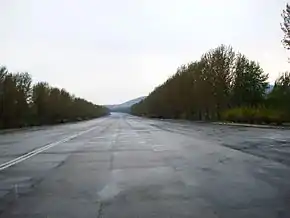.svg.png.webp) | |
|---|---|
| 청년영웅도로 | |
| Pyongyang–Nampo Motorway | |
 | |
 | |
| Route information | |
| Length | 46.3 km[1] (28.8 mi) |
| Existed | October 2000–present |
| Major junctions | |
| North end | Kwangbok Street, Mangyongdae-guyok, Pyongyang[1] |
| South end | Youth Bridge, Hanggu-guyok, Nampo, South Pyongan Province[1] |
| Location | |
| Country | North Korea |
| Highway system | |
The Youth Hero Motorway (Korean: 청년영웅도로; Hanja: 青年英雄道路), also known as the Pyongyang–Nampo Motorway, is a 46.3-kilometre-long (28+3⁄4 mi) expressway in North Korea that connects the cities of Pyongyang, the capital of the country, and Nampo, a city on the coast of Korea Bay in South Pyongan Province. Construction began in November 1998, and the expressway opened in October 2000.[1] It is classified as a level 1 roadway.[2]
The motorway is one of many Stakhanovite "speed battle" projects commissioned by the Workers' Party and carried out rapidly by youth brigades under difficult working conditions.[3] The project involved carrying 14 million cubic metres of earth and included over 80 irrigation structures, 50 bridges, and over 3 million cubic metres of asphalt.[4] Supreme Leader Kim Jong-il inspected the motorway and complimented the youth brigades on November 13 following its opening.
In the event of an armed conflict, the highway serves a defense purpose, allowing tank divisions of the Korean People's Army to block access to Pyongyang.[5]
References
- 1 2 3 4 Sharpe, M. E. (2003). North Korea Handbook. Yonhap News Agency. pp. 396–397.
- ↑ Melvin, Curtis (25 June 2009). "North Korea Uncovered - (Google Earth) - KMZ file". North Korean Economy Watch.
- ↑ Hassig, Ralph; Oh, Kongdan (2009). The Hidden People of North Korea.
- ↑ "Pyongyang-Nampo Motorway Completed". Korean Central News Agency. 13 October 2000. Archived from the original on 4 February 2015. Retrieved 14 June 2013.
- ↑ Madden, Michael (August 3, 2018). "Much Ado About Kangson". Henry L. Stimson Center. Archived from the original on August 3, 2018.
The Pyongyang-Nampo Highway is a key southern defense route for the Pyongyang Defense Command and III Army Corps. In the event of a domestic or foreign attack (from the South) on the DPRK, the 107th and 108th Tank Divisions deploy on the highway to cut off access routes into Pyongyang.